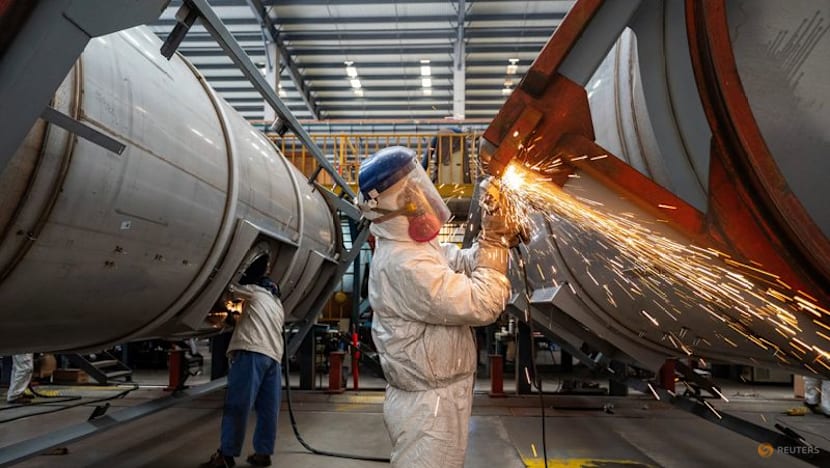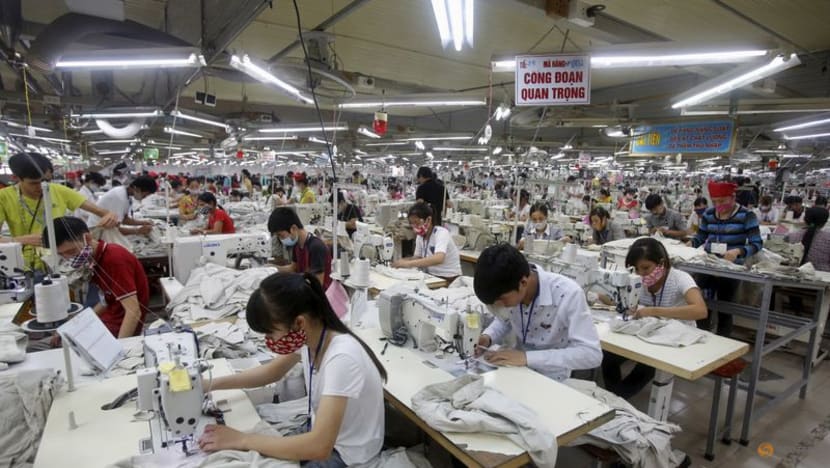World Bank flags slower East Asia growth amid global uncertainty, urges deeper reforms
The World Bank lifted its 2025 growth projection for East Asia to 4.8%, but warned it could slow to 4.3% next year amid rising protectionism and domestic headwinds.

Workers work on a production line, manufacturing tank containers at a factory in Nantong, Jiangsu province, China, on April 7, 2025. (cnsphoto via REUTERS/File Photo)

This audio is generated by an AI tool.
The East Asia and Pacific region continues to outpace much of the world in economic growth, but rising trade barriers, heightened global uncertainty and weaker global growth could slow that momentum, the World Bank cautioned.
In its East Asia and Pacific economic update released on Tuesday (Oct 7), the lender raised its forecast for the region’s gross domestic product (GDP) growth this year to 4.8 per cent, slightly below last year’s 5 per cent.
The pace is expected to slow further, easing to 4.3 per cent in 2026 as rising protectionism and domestic headwinds weigh on regional economies.
However, the region should not view itself as a passive victim of global forces but instead “try and forge their own growth path through deeper domestic reforms”, World Bank’s East Asia and Pacific chief economist Aaditya Mattoo told CNA.
The World Bank’s latest report found that while retail sales are increasing, consumer confidence has yet to return to pre-COVID-19 levels.
Industrial output remains strong, but business sentiment is subdued, it added. Exports in the region accelerated ahead of recent tariff hikes, yet new export orders have been weak.

CHINA’S GROWTH REVISED UPWARD
The World Bank in its report upgraded its economic growth forecast for China.
The world’s second-largest economy is now expected to expand by 4.8 per cent this year, up from 4 per cent projected in April.
The revised forecast brings China closer to its own official target of around 5 per cent.
Last year, China’s economy grew by 5 per cent, fueled by strong exports, stimulus measures and investment in high-tech industries.
Mattoo said the World Bank’s upgrade reflects developments that differed from earlier expectations.
In April, the bank had anticipated more protectionist measures and a pullback in fiscal stimulus due to rising debt levels.
“Those things didn't happen in 2025, but we expect them to happen in 2026,” he noted.
Trade tensions between the United States and China had flared in April, briefly pushing tariffs above 100 per cent.
This was before a trade truce took effect, leaving US duties on Chinese goods at 57.6 per cent - more than double what it was at the start of 2025.
The World Bank expects growth to decline to 4.2 per cent next year. In its report, it cited “an expected slowdown in export growth and a likely reduction in the fiscal stimulus in light of rising public debt, as well as continued structural deceleration”.
Mattoo said with China’s growing public debt, “we expect the government, which is committed to fiscal prudence, to reign in the stimulus”.
He added that the region’s largest economy also faces broader problems.
Beyond the ongoing slump in real estate, manufacturing investment and consumer spending have weakened, which reflects a wider slowdown, said Mattoo. Underlying these trends are long-term drags from an ageing population and declining productivity.
Addressing these issues, Mattoo said, will require “deep structural reforms” to unlock China’s full economic potential.
SOUTHEAST ASIA’S REFORM MOMENTUM
Still, there are some bright spots in Southeast Asia.
For instance, Vietnam is forecast to lead 6.6 per cent growth this year and the Philippines at 5.3 per cent, with both economies buoyed by tariff exemptions in key export sectors and domestic structural reforms.
Mattoo said the two countries have been at the forefront of major reform efforts.
He noted that Vietnam has focused on administrative and governance reforms aimed at improving the efficiency of provincial and local governments.
Meanwhile, the Philippines has opened key sectors - including telecommunications, energy, and logistics - to foreign investment through amendments to its Public Service Act.
“While other countries in the region have succeeded generally in keeping their economies stable, they haven't yet implemented the big deep reforms that would make them grow faster and generate productive jobs for their people,” said Mattoo.
NEW CHALLENGES FOR GROWTH
Still, East Asia and the Pacific face new challenges.
On the employment front, the World Bank report said that creating more quality jobs remains central to the region’s development.
Although most people seeking work can find jobs, much of the recent employment growth has been in low-productivity, often informal service work offering few opportunities for advancement, the World Bank report stated.
Today, many workers in the region must also contend with the growing use of robots, artificial intelligence and digital platforms - trends that are reshaping industries and labor markets.
Rapid advances in these technologies call for new skills and greater adaptability from firms, workers and policymakers, according to the report.
The region continues to perform well by global standards, but lags behind its own potential and the ambitions of its leaders, the report added. Youth unemployment remains high, and women continue to be underrepresented in the workforce.
Mattoo pointed out that the share of the population vulnerable to falling into poverty is now greater than the middle class in most countries in the region.
The World Bank said sustaining growth will demand investments in human capital and digital infrastructure, greater competition in services, and policies that better align job opportunities with workers’ skills.
It urged countries to focus on long-term growth, warning that short-term fiscal stimulus provides less lasting benefits than structural reforms.
Mattoo stressed the need for bolder changes, including removing barriers to business entry and competition, and strengthening education and employment outcomes.
“This is a class of reforms we think are urgent and some countries fortunately are beginning to implement them,” he added.

















